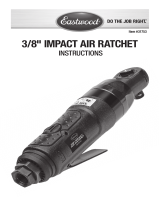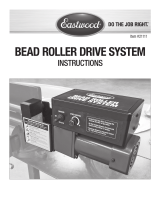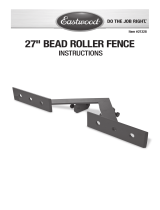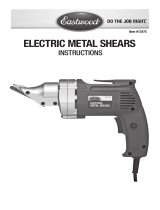Page is loading ...

ELECTRIC 1/2"
MINI BELT SANDER
INSTRUCTIONS
Item #31672

2 Eastwood Technical Assistance: 800.343.9353 >> techelp@eastwood.com
The EASTWOOD ELECTRIC 1/2" MINI BELT SANDER is great for fi ne sanding and grinding jobs on
virtually all metals including steel, aluminum, brass and more. Uses common 1/2" x 18" abrasive belts
for convenience. The compact design allows access to tight places where larger Belt Sanders can’t go.
INCLUDES
(1) Sander
(1) Abrasive Belt
(1) 3mm Hex Key
SPECIFICATIONS
Input Voltage: 120 VAC, 60 Hz
Input Amperage: 5.3 Amps
Plug Type: 2-prong, polarized
Cord Length: 7'- 6"
Certification: ETL
No-Load Speed: 2300 Feet Per Minute
Belt Size: 1/2" x 18"
DANGER indicates a hazardous situation which, if not avoided, will result in death or serious injury.
WARNING indicates a hazardous situation which, if not avoided, could result in death or serious injury.
CAUTION used with the safety alert symbol, indicates a hazardous situation which, if not avoided,
could result in minor or moderate injury.
NOTICE is used to address practices not related to personal injury.
IMPORTANT SAFETY INFORMATION
The following explanations are displayed in this manual, on the labeling,
and on all other information provided with this product:
for convenience. The compact design allows access to tight places where larger Belt Sanders can’t go.
SPECIFICATIONS

To order parts and supplies: 800.343.9353 >> eastwood.com 3
IMPORTANT SAFETY INFORMATION
GENERAL SAFETY RULES
Read all instructions. Failure to follow all instructions listed below may result in electric shock,
fire and/or serious injury. The term “power tool” in all of the warnings listed below refers to your
mains-operated (corded) power tool or battery-operated (cordless) power tool.
SAVE THESE INSTRUCTIONS
1) WORK AREA SAFETY
a) Keep work area clean and well lit. Cluttered or dark areas invite accidents.
b) Do not operate power tools in explosive atmospheres, such as in the presence of flammable
liquids, gases or dust. Power tools create sparks which may ignite the dust or fumes.
c) Keep children and bystanders away while operating a power tool. Distractions can cause you
to lose control.
2) ELECTRICAL SAFETY
a) Power tool plugs must match the outlet. Never modify the plug in any way. Do not use any
adapter plugs with earthed (grounded) power tools. Unmodified plugs and matching outlets
will reduce risk of electric shock.
b) Avoid body contact with earthed or grounded surfaces such as pipes, radiators, ranges and
refrigerators. There is an increased risk of electric shock if your body is earthed or grounded.
c) Do not expose power tools to rain or wet conditions. Water entering a power tool will increase
the risk of electric shock.
d) Do not abuse the cord. Never use the cord for carrying, pulling or unplugging the power tool.
Keep cord away from heat, oil, sharp edges or moving parts. Damaged or entangled cords
increase the risk of electric shock.
e) When operating a power tool outdoors, use an extension cord suitable for outdoor use.
Use of a cord suitable for outdoor use reduces the risk of electric shock.
NOTE: Use a minimum 14 gauge insulated cord, no longer than 25’ in length.

4 Eastwood Technical Assistance: 800.343.9353 >> techelp@eastwood.com
3) PERSONAL SAFETY
a) Stay alert, watch what you are doing and use common sense when operating a power tool. Do
not use a power tool while you are tired or under the influence of drugs, alcohol or medication.
A moment of inattention while operating power tools may result in serious personal injury.
b) Use safety equipment. Always wear eye protection. Safety equipment such as dust mask,
non-skid safety shoes, hard hat, or hearing protection used for appropriate conditions will
reduce personal injuries.
c) Avoid accidental starting. Ensure the switch is in the off-position before plugging in.
Carrying power tools with your finger on the switch or plugging in power tools that have
the switch on invites accidents.
d) Remove any adjusting key or wrench before turning the power tool on. A wrench or a key
left attached to a rotating part of the power tool may result in personal injury.
e) Do not overreach. Keep proper footing and balance at all times. This enables better control
of the power tool in unexpected situations.
f) Dress properly. Do not wear loose clothing or jewelry. Keep your hair, clothing and gloves away
from moving parts. Loose clothes, jewelry or long hair can be caught in moving parts.
g) If devices are provided for the connection of dust extraction and collection facilities, ensure
these are connected and properly used. Use of these devices can reduce dust-related hazards.
4) POWER TOOL USE AND CARE
a) Do not force the power tool. Use the correct power tool for your application. The correct power
tool will do the job better and safer at the rate for which it was designed.
b) Do not use the power tool if the switch does not turn it on and off. Any power tool that cannot
be controlled with the switch is dangerous and must be repaired.
c) Disconnect the plug from the power source and/or the battery pack from the power tool before
making any adjustments, changing accessories, or storing power tools. Such preventive safety
measures reduce the risk of starting the power tool accidentally.
d) Store idle power tools out of the reach of children and do not allow persons unfamiliar with the
power tool or these instructions to operate the power tool. Power tools are dangerous in the
hands of untrained users.
e) Maintain power tools. Check for misalignment or binding of moving parts, breakage of parts
and any other condition that may affect the power tools operation. If damaged, have the power
tool repaired before use. Many accidents are caused by poorly maintained power tools.
f) Keep cutting tools sharp and clean. Properly maintained cutting tools with sharp cutting edges
are less likely to bind and are easier to control.
g) Use the power tool, accessories and tool bits etc., in accordance with these instructions and
in the manner intended for the particular type of power tool, taking into account the working
conditions and the work to be performed. Use of the power tool for operations different from
those intended could result in a hazardous situation.
5) SERVICE
a) Have your power tool serviced by a qualified repair person using only identical replacement
parts. This will ensure that the safety of the power tool is maintained.

To order parts and supplies: 800.343.9353 >> eastwood.com 5
SHOCK HAZARD!
• Never operate or store Sander in damp or wet conditions.
• Plug into a minimum 15 amp circuit. If using an extension cord, it must be
AWG 14 or greater, no longer than 25'.
HEALTH AND INJURY HAZARDS!
• Dust and fine particles are generated while cutting which can contain
hazardous or toxic substances. Breathing this dust can cause many serious
respiratory health conditions. Always use NIOSH approved respiratory
protection while using this Sander.
• This Sander will eject particles, dust and sparks at high velocity during
operation. Wear approved eye and skin protection at all times while operating.
• Use of this Sander can generate excessive noise. Wear appropriate hearing
protection while using.
• The moving Abrasive Belt of this Sander can quickly catch loose clothing, long
hair or jewelry causing serious personal injury. Keep all loose clothing, long
hair and jewelry away from operating Sander.
• This Sander can quickly start up when handling while plugged in to electrical
supply causing serious personal injury. Always unplug the tool from the
electrical supply before changing Abrasive Belts or performing maintenance.
• Sharp metal edges can cut. Always wear protective work gloves while
handling.
• Moving Abrasive Belts can quickly cut flesh. Keep hands and fingers away
from moving Abrasive Belt.
• This Sander can quickly and violently kick back or twist while operating
causing severe hand and or wrist injury. Do not apply excessive force to
Sander while in use. Always make sure the workpiece or material being cut is
securely clamped or anchored to allow two handed operation of the Sander.
• Damaged Abrasive Belts can break at high speed causing personal injury or
property damage. If excessive vibration is felt, discontinue use immediately
and disconnect tool from electrical supply. Inspect Abrasive Belt and Sander
for damage. Do not resume use until resolution is found.
• This Sander will eject a trail of sparks at high speed which can ignite
flammable materials or injure others nearby. Do not operate in the vicinity of
flammable materials and keep all persons and pets away from the work area.
ADDITIONAL SAFETY INFORMATION

6 Eastwood Technical Assistance: 800.343.9353 >> techelp@eastwood.com
OPERATION
• Loosen the Arm Locking Knob, adjust Arm to the desired angle then securely re-tighten the
Arm Locking Knob (Fig 1).
• While holding the Sander securely in two hands, slide the ON/OFF Switch located on top of the
Sander body forward (Fig 2).*
• To begin sanding, allow
several seconds for the
motor to reach full speed
then gently feed the
Abrasive Belt into the
workpiece.
• Slowly and steadily allow the
abrasive of the Abrasive Belt
to do the work.
• When the sanding is
complete, release the
Switch and allow the
Abrasive Belt to stop before
pulling away from the
workpiece.
The switch can be locked in the “on” position by depressing the front of the
switch while sliding it forward. Tap the rear of the switch to unlock and turn
off the sander.
DO NOT force the Sander or kickback could quickly occur causing severe injury!
Arm
Locking
Knob
FIG. 1
✓
FIG. 2
✓
ON/OFF Switch
*

To order parts and supplies: 800.343.9353 >> eastwood.com 7
ABRASIVE BELT REMOVAL
• Using the included 3mm Hex
Key, remove the Retaining
Screw and Belt Drive Cover
(Fig 3).
• Rotate the Abrasive Belt
Tensioner Lever 90° Counter-
Clockwise to release tension
on Belt (Fig 4).
• Pull out Abrasive Belt (Fig 5).
This Sander can quickly start up when handling while plugged in to electrical
supply causing serious personal injury. Always unplug the Sander from the
electrical supply before changing Abrasive Belts or performing maintenance.
Abrasive Belt edges can be abrasive to flesh. Always wear protective work
gloves while handling.
FIG. 3
FIG. 4
FIG. 5
Rotate
90°

8 Eastwood Technical Assistance: 800.343.9353 >> techelp@eastwood.com
ABRASIVE BELT INSTALLATION
• Install replacement Belt.
• Rotate the Abrasive Belt Tensioner Lever 90° Clockwise (so that it is in-line with the Arm) to
introduce tension on Belt (Fig 6).
• Replace the Belt Drive Cover and Retaining Screw.
ABRASIVE BELT TRACKING ADJUSTMENT
• Rotate the Belt Tracking Knob located on the right side of the Arm (Fig 6) Counter-Clockwise to
track left; Clockwise to track right.
Belt
Tension
Lever
Tracking
Knob
✓
FIG. 6
✓

To order parts and supplies: 800.343.9353 >> eastwood.com 9
MAINTENANCE
IMPORTANT NOTE: The following maintenance should be performed before each use:
• Inspect Abrasive Belt for cracks, damage or premature wear.
• Clean dirt and debris from motor air cooling slots.
• Clean dirt and debris from Abrasive Belt Mounting Shaft.

10 Eastwood Technical Assistance: 800.343.9353 >> techelp@eastwood.com
PROBLEM CAUSE CORRECTION
Does Not Run
When Switch
is Depressed
No Electric
Power to
Sander
Check 120 VAC input plug connection.
Check for tripped circuit breaker.
Motor Runs
Too Slow/
Develops Low
Power
Undersized or
Too Long of an
Extension Cord
Use only 14 gauge or larger cord.
Limit length to 25'
Excessive
Noise and/or
Vibration
Abrasive Belt
is Damaged
WARNING: This is an extremely dangerous
condition! Stop use and replace Abrasive Belt!
Motor
Overheats
Excessive
Pressure Being
Applied to
Abrasive Belt
Allow Allow the tool to do the work. Do Not force!
Dirt and Debris
Buildup in
Motor Cooling
Air Slots
Use a brush or compressed air to remove debris.
TROUBLESHOOTING

To order parts and supplies: 800.343.9353 >> eastwood.com 11

© Copyright 2017 Easthill Group, Inc. 3/17 Instruction item #31660Q Rev 2
If you have any questions about the use of this product, please contact
The Eastwood Technical Assistance Service Department: 800.343.9353 >> email: techelp@eastwood.com
PDF version of this manual is available online >> eastwood.com/31672manual
The Eastwood Company 263 Shoemaker Road, Pottstown, PA 19464, USA
US and Canada: 800.343.9353 Outside US: 610.718.8335
Fax: 610.323.6268 eastwood.com
ADDITIONAL ITEMS
#28038 Sheet Metal Gauge
#13475 Electric Metal Cutting Shears
#28187 Bead Roller Kit
#51088 Shrinker/Stretcher Set
#31458 (5) 40 Grit Abrasive Belt
#31456 (5) 80 Grit Abrasive Belt
#31457 (5) 120 Grit Abrasive Belt
/








